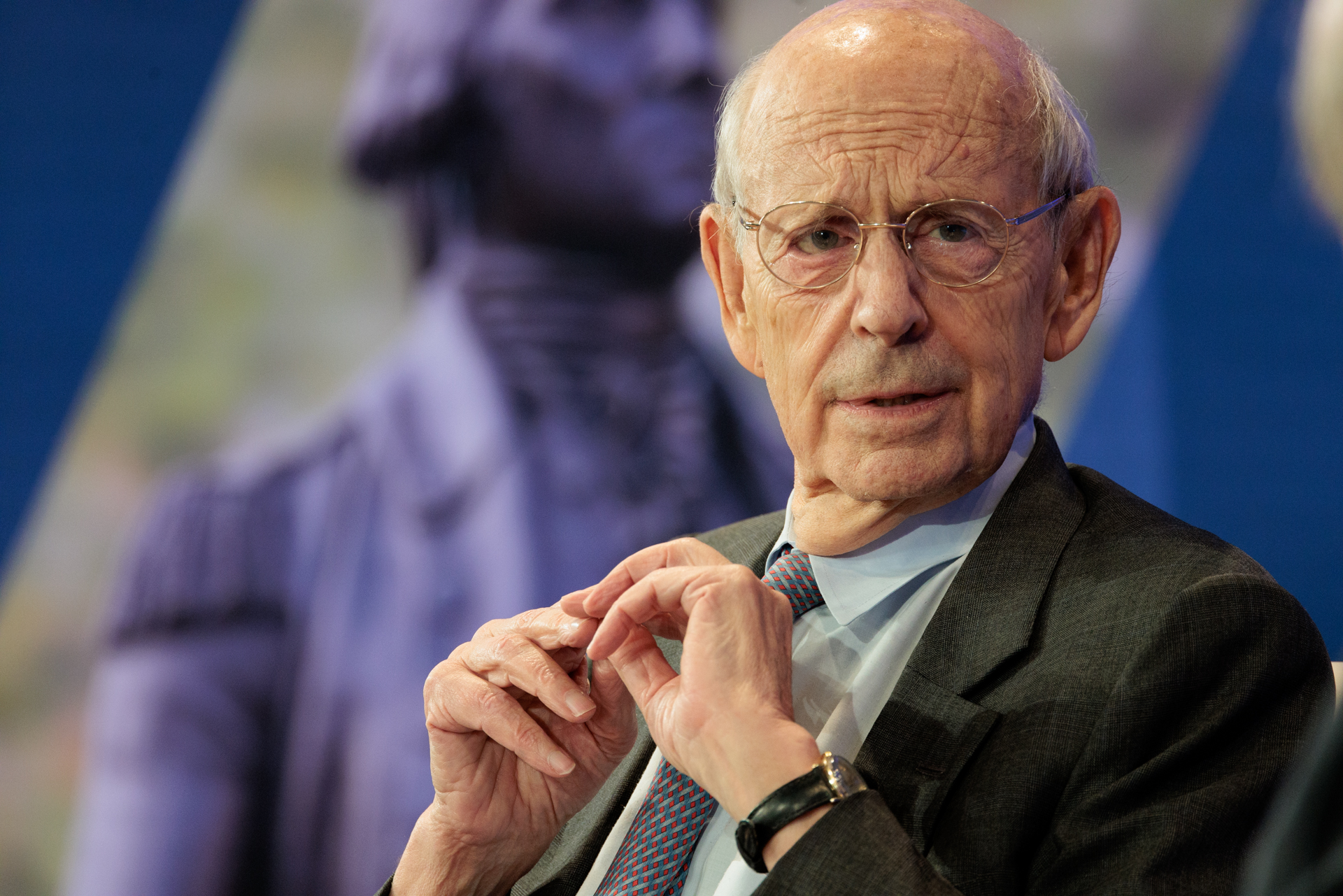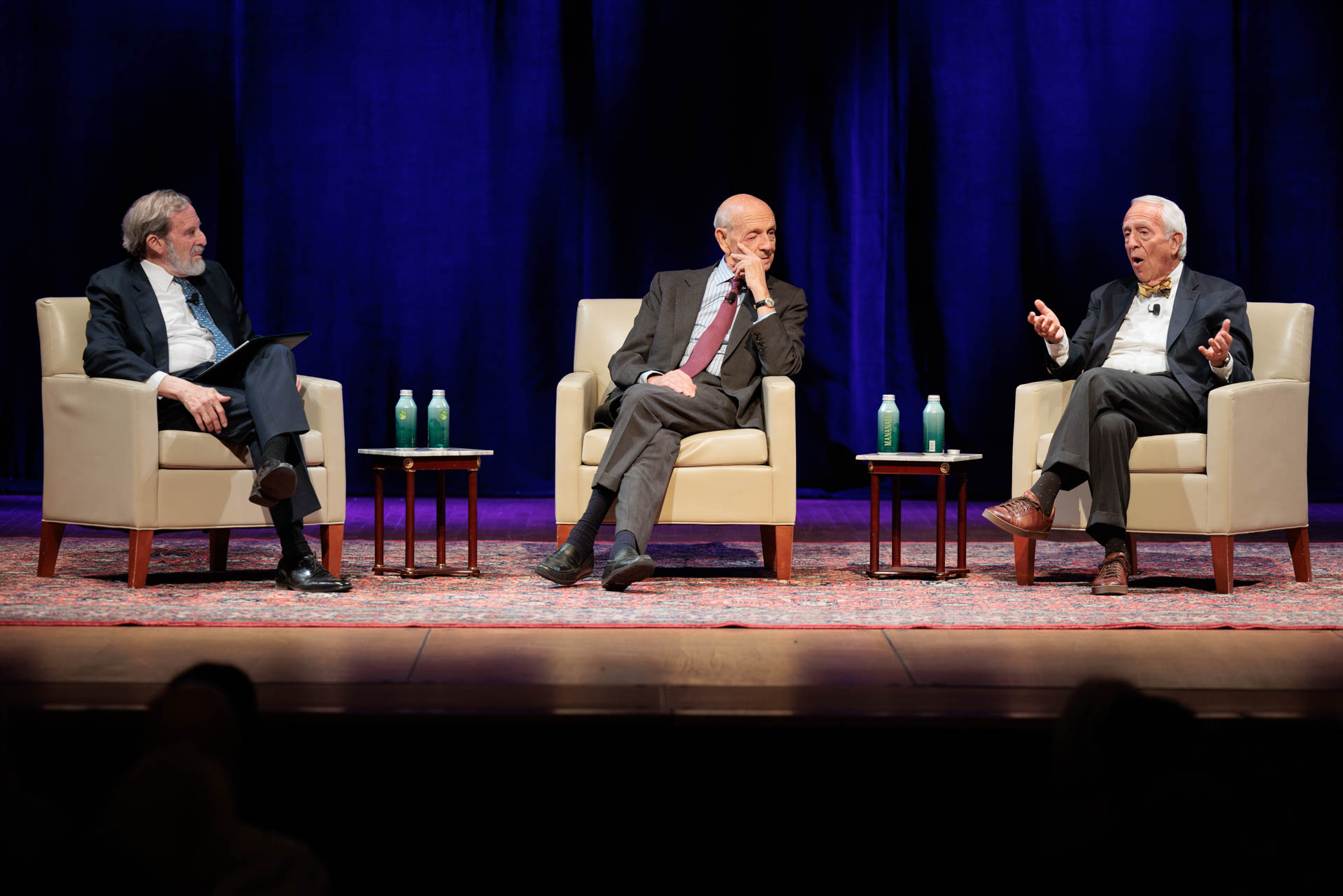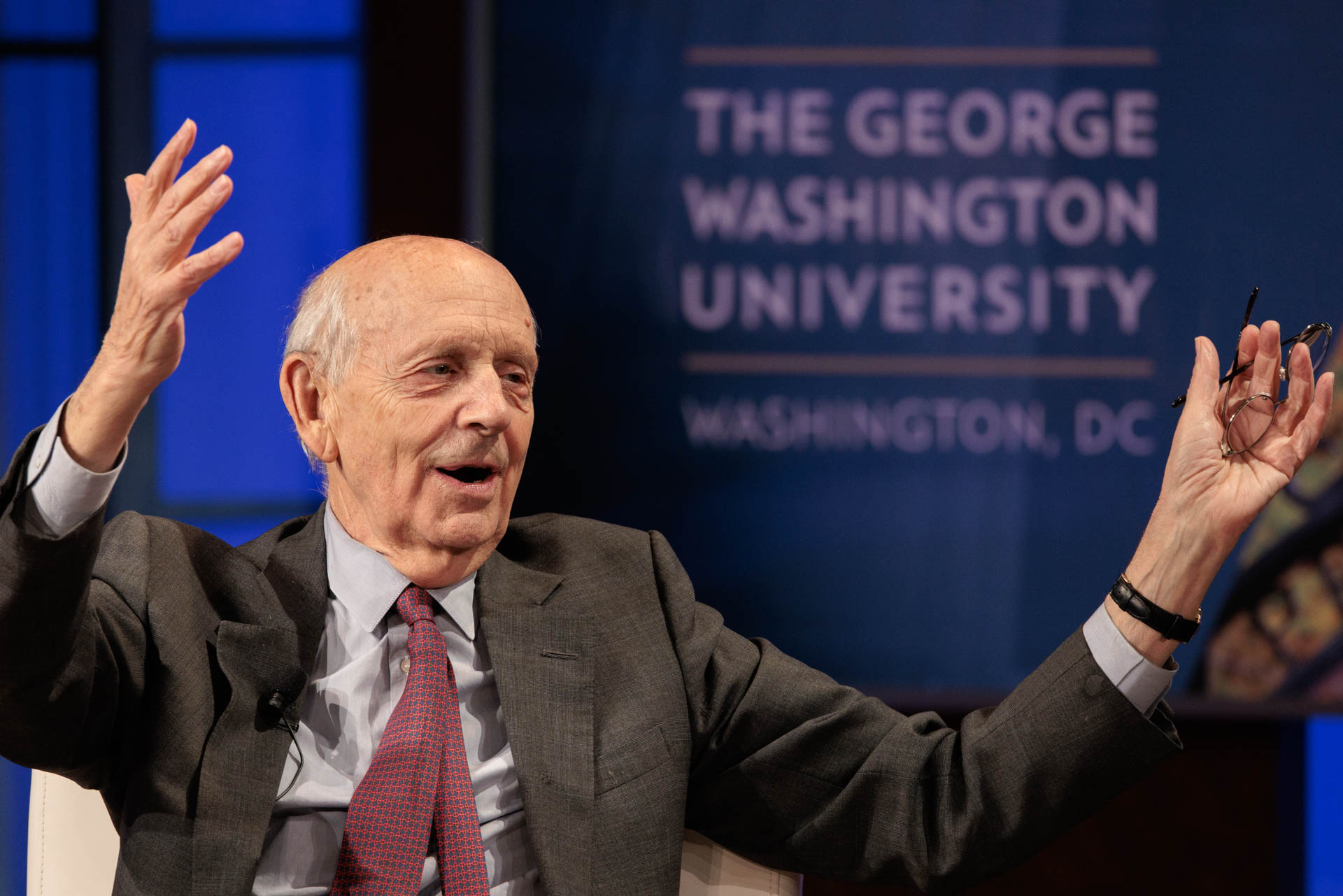Retired U.S. Supreme Court Justice Stephen Breyer returned to campus for the fifth in a series of dialogues billed as “An Oral History of the Arc of a Great Career,” hosted by GW Law. Smoothly steered through the concluding conversation by his longtime friend Alan B. Morrison, the Lerner Family Associate Dean for Public Interest and Public Service Law, Justice Breyer answered questions about his time on the Supreme Court and about his new book, “Reading the Constitution: Why I Chose Pragmatism, Not Textualism” (Simon & Schuster).
Brief opening remarks were made by Michael Hogan, assistant vice president for development and alumni relations for GW Law, and by Dayna Bowen Matthew, the school’s dean. Matthew introduced George Washington University President Ellen M. Granberg, thanking her for “steady and wise leadership.” Granberg offered a sketch of Justice Breyer’s career before praising him as a “21st-century Renaissance man.”
Morrison began by asking Justice Breyer if he felt prepared when in 1994 he was nominated to the Supreme Court. He said he wanted the job, but felt “stark fear” for his first year or two on the nation’s highest court. There are always areas of the law which a given individual knows nothing about, he said.
Nonetheless, he added, “The most I can do is the best I can, and that’s true of virtually any job that you’re going to get in law or any other profession.”
He was a little surprised, he said, to realize how independent he would be in his new post. The nature of being a justice, he added, is that the only one who really knows if you’re doing it right or wrong is you.
“You have to listen to other judges on the court, but you decide independently,” he said.
Morrison moved the conversation to a consideration, first, of the certiorari process by which the court determines which cases to hear, and then to oral arguments. One of the most important parts of a Supreme Court justice’s job, Morrison said, is deciding what cases to take.
“You probably can’t do much harm by not taking a case,” Justice Breyer said.
“Except, perhaps, to the lawyer who filed the cert petition,” Morrison replied.
When hearing oral arguments, Justice Breyer said, it’s important to be open-minded. “It isn’t that you’re blank-minded,” he said, “it means being willing to change your mind.” He likened the briefs submitted in each case to “little pamphlets,” and then said, “They’re not brief. I don’t know why they call them briefs.”
When Morrison asked if he discussed cases privately with other justices, he said it rarely happened. First, he said, anything you say might be taken as an indication of how you’re planning to rule, and in any case the other justices will get an idea of that from oral arguments. And the arguments presented, he added, might change how you think about a case, which affects how you write about it, even if they don’t affect your ultimate ruling. How you write about the case can have reverberating effects.
The best questions to ask in oral arguments, Justice Breyer said, are the ones to which you genuinely don’t know the answers.
Shifting the talk to Justice Breyer’s latest book, Morrison gave him a chance to respond to two main criticisms the work has received. The first is that it pulls readers into the weeds in discussions of legal cases.
“People who aren’t lawyers will have to work a little bit,” Justice Breyer conceded, adding that he wanted readers to have a full understanding of his approach.
The other criticism is that he’s too fair-minded in attributing the best of motives to his colleagues, who (to some observers) often seem politically motivated.
“It’s more open in my experience than people think,” Justice Breyer said. “I do not see politics.”
Perhaps, Morrison suggested, ideology is at play more than politics.
“Ideology does play a role,” he agreed. “You can’t jump out of your own skin.”
The new book takes a firm stand against the textualist or originalist approach taken by jurists who say they rely on a strict reading of the Constitution and what it meant to its framers.
His objections to these approaches, Justice Breyer said, are numerous. The strict definitions of words, even when they are crystal clear, don’t necessarily indicate how they should be applied in the case under consideration. The Constitution, he added, is general and abstract. He favors trying to understand the principles underlying the words in the Constitution before applying them to the statute in question.
One big problem with originalism, he said, to an outburst of applause from the audience, is that at the time the document was written, much of the population wasn’t recognized by the Constitution as full citizens. He thinks what motivates justices to insist on an originalist approach is that otherwise issues can quickly become complicated.
The appeal of the originalist approach, he said, is fourfold: First, it promises to simplify matters (“Just read the words”). Second, it might seem to be a way of ensuring fairness, removing personal preferences from consideration. Third, it helps Congress interpret and make laws. And fourth, it hems in other judges who might veer widely in their decisions.
“Those are great promises,” Justice Breyer said. “Unfortunately, none of them can be kept.”
Morrison concluded by asking about stare decisis, the principle that legal precedent must be respected. The Supreme Court’s decision in Dobbs v. Jackson Women’s Health Organization in 2022 overturned its ruling 50 years earlier in Roe v. Wade, which protected women’s right to choose an abortion.
“Where do we stand with stare decisis?” Morrison asked. “Is everything up for grabs?”
If stare decisis were carved in stone, Justice Breyer said, we wouldn’t have positive outcomes as in Brown v. Board of Education, the landmark decision in 1954 when the court overturned precedent maintaining that racial segregation in schools was acceptable so long as population groups kept separate were provided with equal facilities.
Originalists maintain that without leaning on the text of the Constitution, judges are simply ruling from their gut on whether an outcome will be good or bad. Justice Breyer pointed out that, in his view, originalists do just that. In the end, everyone is ruling with a view to the outcome they think is best. Therefore, it behooves justices to learn as much as they can about an issue and to listen carefully to the arguments from the other side.
In the Dobbs case, he said, some of his colleagues on the bench voted to overturn Roe because they felt it was wrong.
“How do you know it’s wrong?” he asked rhetorically. “It’s a big country with 320 million people. They all think differently and they’ve got to live together.”
As the discussion concluded, Matthew invited law students onstage for a photograph with Justice Breyer. “You’re going into practice at a difficult time for the country,” he told them. He then offered advice he has given previously: Talk to people who disagree with you, and give them credit. It’s better to get a percentage of what you want than to be a scorched-earth purist.






